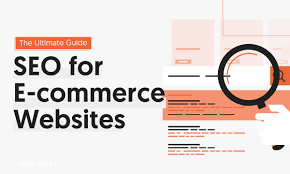Unlocking Success: The Power of SEO in Ecommerce
The Importance of SEO in Ecommerce
Search Engine Optimization (SEO) plays a crucial role in the success of any ecommerce business. With the ever-increasing competition in the online marketplace, having a strong SEO strategy is essential to stand out from the crowd and attract potential customers.
Optimising Product Pages
One of the key aspects of SEO in ecommerce is optimising product pages. By conducting keyword research and incorporating relevant keywords into product titles, descriptions, and meta tags, you can improve your website’s visibility in search engine results.
Creating High-Quality Content
Content is king when it comes to SEO. By creating high-quality and engaging content such as blog posts, product guides, and how-to articles, you can not only drive organic traffic to your ecommerce site but also establish your brand as an authority in your industry.
Building Quality Backlinks
Backlinks are an important ranking factor for search engines. By building quality backlinks from reputable websites within your industry, you can improve your site’s credibility and authority, which can positively impact your search engine rankings.
Optimising for Mobile
In today’s mobile-first world, it is crucial to ensure that your ecommerce website is mobile-friendly. Search engines prioritise mobile-optimised sites in their rankings, so optimising your site for mobile devices can significantly boost your SEO performance.
Monitoring Performance
Regularly monitoring and analysing the performance of your ecommerce site is essential for effective SEO. By tracking key metrics such as organic traffic, conversion rates, and bounce rates, you can identify areas for improvement and make data-driven decisions to enhance your SEO strategy.
Conclusion
In conclusion, SEO plays a vital role in the success of ecommerce businesses by improving online visibility, driving organic traffic, and increasing conversions. By implementing a comprehensive SEO strategy that focuses on optimising product pages, creating high-quality content, building quality backlinks, optimising for mobile, and monitoring performance metrics, you can position your ecommerce business for long-term success in the competitive online marketplace.
Top 5 SEO Tips for Boosting Your E-commerce Success
- Optimize product titles and descriptions with relevant keywords
- Create SEO-friendly URLs for product pages
- Utilize image alt text to improve visibility in image searches
- Generate high-quality backlinks from reputable websites
- Regularly update and refresh content to maintain search engine rankings
Optimize product titles and descriptions with relevant keywords
To enhance the visibility of your ecommerce website and attract potential customers, it is crucial to optimise product titles and descriptions with relevant keywords. By conducting thorough keyword research and strategically incorporating these keywords into your product titles and descriptions, you can improve your website’s search engine rankings and make it easier for users to find your products online. This SEO tip not only boosts organic traffic but also increases the chances of converting visitors into customers by providing them with clear and relevant information about your products.
Create SEO-friendly URLs for product pages
Creating SEO-friendly URLs for product pages is a fundamental tip in ecommerce SEO. By incorporating relevant keywords and clear, descriptive language into the URLs of product pages, businesses can enhance their search engine visibility and improve the chances of ranking higher in search results. SEO-friendly URLs not only make it easier for search engines to understand the content of a page but also provide a better user experience by conveying valuable information about the product being offered. This simple yet effective practice can have a significant impact on driving organic traffic and ultimately boosting sales for ecommerce websites.
Utilize image alt text to improve visibility in image searches
Utilising image alt text is a valuable tip for enhancing SEO in ecommerce. By providing descriptive and relevant alt text for images on your website, you not only improve accessibility for visually impaired users but also enhance your visibility in image searches. Search engines rely on alt text to understand the content of images, so by incorporating targeted keywords into your alt text, you can increase the likelihood of your products appearing in search results and drive more organic traffic to your ecommerce site. This simple yet effective strategy can significantly boost your online presence and help potential customers discover your products through image searches.
Generate high-quality backlinks from reputable websites
Generating high-quality backlinks from reputable websites is a crucial aspect of SEO in ecommerce. By establishing links from trustworthy and authoritative sites within your industry, you not only enhance your website’s credibility and trustworthiness in the eyes of search engines but also increase the likelihood of driving relevant traffic to your ecommerce site. These backlinks act as a vote of confidence for your online store, helping to improve your search engine rankings and ultimately boost your visibility and organic traffic, leading to increased sales and conversions.
Regularly update and refresh content to maintain search engine rankings
To maintain search engine rankings in ecommerce, it is crucial to regularly update and refresh content on your website. Search engines value fresh and relevant content, so by consistently updating product descriptions, blog posts, and other content, you can signal to search engines that your site is active and engaging. This practice not only helps in retaining current rankings but also attracts new visitors and improves overall SEO performance by demonstrating your commitment to providing up-to-date information to users.
